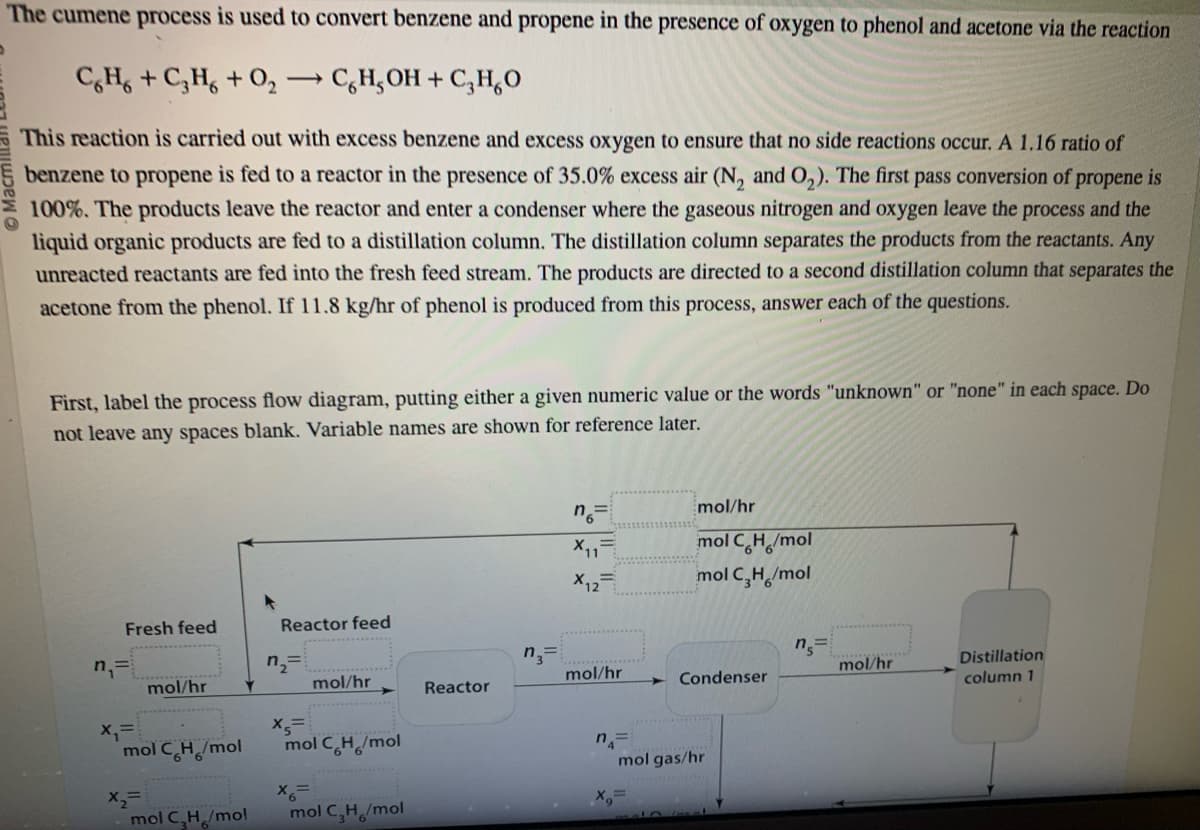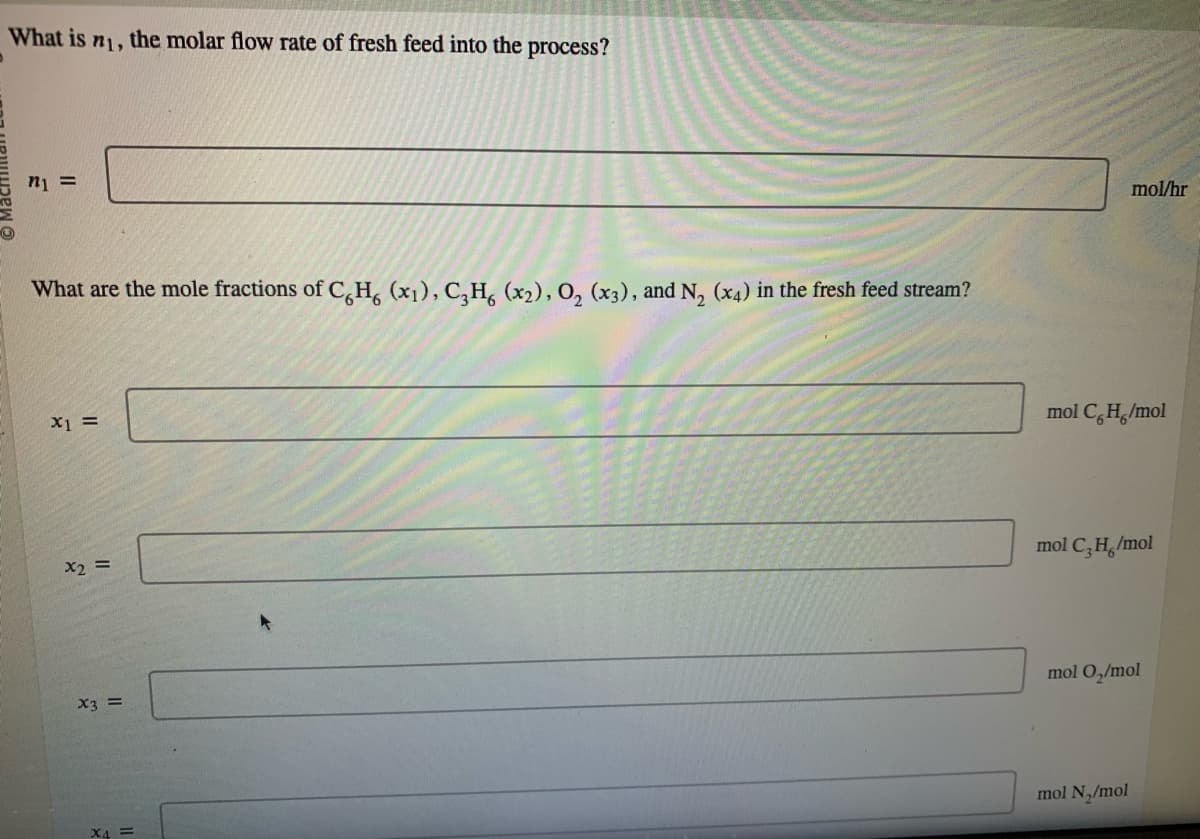The cumene process is used to convert benzene and propene in the presence of oxygen to phenol and acetone via the reaction CH+C3H6+0₂ CH₂OH + C₂H₂O This reaction is carried out with excess benzene and excess oxygen to ensure that no side reactions occur. A 1.16 ratio of benzene to propene is fed to a reactor in the presence of 35.0% excess air (N₂ and O₂). The first pass conversion of propene is 100%. The products leave the reactor and enter a condenser where the gaseous nitrogen and oxygen leave the process and the liquid organic products are fed to a distillation column. The distillation column separates the products from the reactants. Any unreacted reactants are fed into the fresh feed stream. The products are directed to a second distillation column that separates th acetone from the phenol. If 11.8 kg/hr of phenol is produced from this process, answer each of the questions. First, label the process flow diagram, putting either a given numeric value or the words "unknown" or "none" in each space. Do not leave any spaces blank. Variable names are shown for reference later. Fresh feed n₁= x₁= mol/hr mol CH/mol Reactor feed n₂= x= mol/hr mol CH /mol X₁ = Reactor n3= n X11 X12 mol/hr n= mol/hr mol C H/mol mol C₂H/mol Condenser mol gas/hr n= mol/hr Distillation column 1
The cumene process is used to convert benzene and propene in the presence of oxygen to phenol and acetone via the reaction CH+C3H6+0₂ CH₂OH + C₂H₂O This reaction is carried out with excess benzene and excess oxygen to ensure that no side reactions occur. A 1.16 ratio of benzene to propene is fed to a reactor in the presence of 35.0% excess air (N₂ and O₂). The first pass conversion of propene is 100%. The products leave the reactor and enter a condenser where the gaseous nitrogen and oxygen leave the process and the liquid organic products are fed to a distillation column. The distillation column separates the products from the reactants. Any unreacted reactants are fed into the fresh feed stream. The products are directed to a second distillation column that separates th acetone from the phenol. If 11.8 kg/hr of phenol is produced from this process, answer each of the questions. First, label the process flow diagram, putting either a given numeric value or the words "unknown" or "none" in each space. Do not leave any spaces blank. Variable names are shown for reference later. Fresh feed n₁= x₁= mol/hr mol CH/mol Reactor feed n₂= x= mol/hr mol CH /mol X₁ = Reactor n3= n X11 X12 mol/hr n= mol/hr mol C H/mol mol C₂H/mol Condenser mol gas/hr n= mol/hr Distillation column 1
Introduction to Chemical Engineering Thermodynamics
8th Edition
ISBN:9781259696527
Author:J.M. Smith Termodinamica en ingenieria quimica, Hendrick C Van Ness, Michael Abbott, Mark Swihart
Publisher:J.M. Smith Termodinamica en ingenieria quimica, Hendrick C Van Ness, Michael Abbott, Mark Swihart
Chapter1: Introduction
Section: Chapter Questions
Problem 1.1P
Related questions
Question
Post steps please!!

Transcribed Image Text:The cumene process is used to convert benzene and propene in the presence of oxygen to phenol and acetone via the reaction
CH + C3H6+0₂
CH₂OH + C₂H₂O
This reaction is carried out with excess benzene and excess oxygen to ensure that no side reactions occur. A 1.16 ratio of
benzene to propene is fed to a reactor in the presence of 35.0% excess air (N₂ and O₂). The first pass conversion of propene is
100%. The products leave the reactor and enter a condenser where the gaseous nitrogen and oxygen leave the process and the
liquid organic products are fed to a distillation column. The distillation column separates the products from the reactants. Any
unreacted reactants are fed into the fresh feed stream. The products are directed to a second distillation column that separates the
acetone from the phenol. If 11.8 kg/hr of phenol is produced from this process, answer each of the questions.
First, label the process flow diagram, putting either a given numeric value or the words "unknown" or "none" in each space. Do
not leave any spaces blank. Variable names are shown for reference later.
Fresh feed
n₁=
x₁=
mol/hr
mol CH/mol
X₂=
-
mol C₂H/mol
Reactor feed
n₂=
X5=
mol/hr
mol CH /mol
x=
mol C₂H/mol
Reactor
n3=
n6=
X11
X12
mol/hr
n₁
mol/hr
mol CH/m
mol C₂H/mol
X₂²
Condenser
mol gas/hr
/mol
n=
mol/hr
Distillation
column 1

Transcribed Image Text:What is n1,
n1 =
What are the mole fractions of C,H, (x₁), C3H6 (x2), O₂ (x3), and N₂ (x4) in the fresh feed stream?
x1 =
x₂ =
the molar flow rate of fresh feed into the process?
x3 =
X4 =
mol/hr
mol CH /mol
mol C₂H/mol
mol O₂/mol
mol N₂/mol
Expert Solution
This question has been solved!
Explore an expertly crafted, step-by-step solution for a thorough understanding of key concepts.
Step by step
Solved in 3 steps

Recommended textbooks for you

Introduction to Chemical Engineering Thermodynami…
Chemical Engineering
ISBN:
9781259696527
Author:
J.M. Smith Termodinamica en ingenieria quimica, Hendrick C Van Ness, Michael Abbott, Mark Swihart
Publisher:
McGraw-Hill Education

Elementary Principles of Chemical Processes, Bind…
Chemical Engineering
ISBN:
9781118431221
Author:
Richard M. Felder, Ronald W. Rousseau, Lisa G. Bullard
Publisher:
WILEY

Elements of Chemical Reaction Engineering (5th Ed…
Chemical Engineering
ISBN:
9780133887518
Author:
H. Scott Fogler
Publisher:
Prentice Hall

Introduction to Chemical Engineering Thermodynami…
Chemical Engineering
ISBN:
9781259696527
Author:
J.M. Smith Termodinamica en ingenieria quimica, Hendrick C Van Ness, Michael Abbott, Mark Swihart
Publisher:
McGraw-Hill Education

Elementary Principles of Chemical Processes, Bind…
Chemical Engineering
ISBN:
9781118431221
Author:
Richard M. Felder, Ronald W. Rousseau, Lisa G. Bullard
Publisher:
WILEY

Elements of Chemical Reaction Engineering (5th Ed…
Chemical Engineering
ISBN:
9780133887518
Author:
H. Scott Fogler
Publisher:
Prentice Hall


Industrial Plastics: Theory and Applications
Chemical Engineering
ISBN:
9781285061238
Author:
Lokensgard, Erik
Publisher:
Delmar Cengage Learning

Unit Operations of Chemical Engineering
Chemical Engineering
ISBN:
9780072848236
Author:
Warren McCabe, Julian C. Smith, Peter Harriott
Publisher:
McGraw-Hill Companies, The